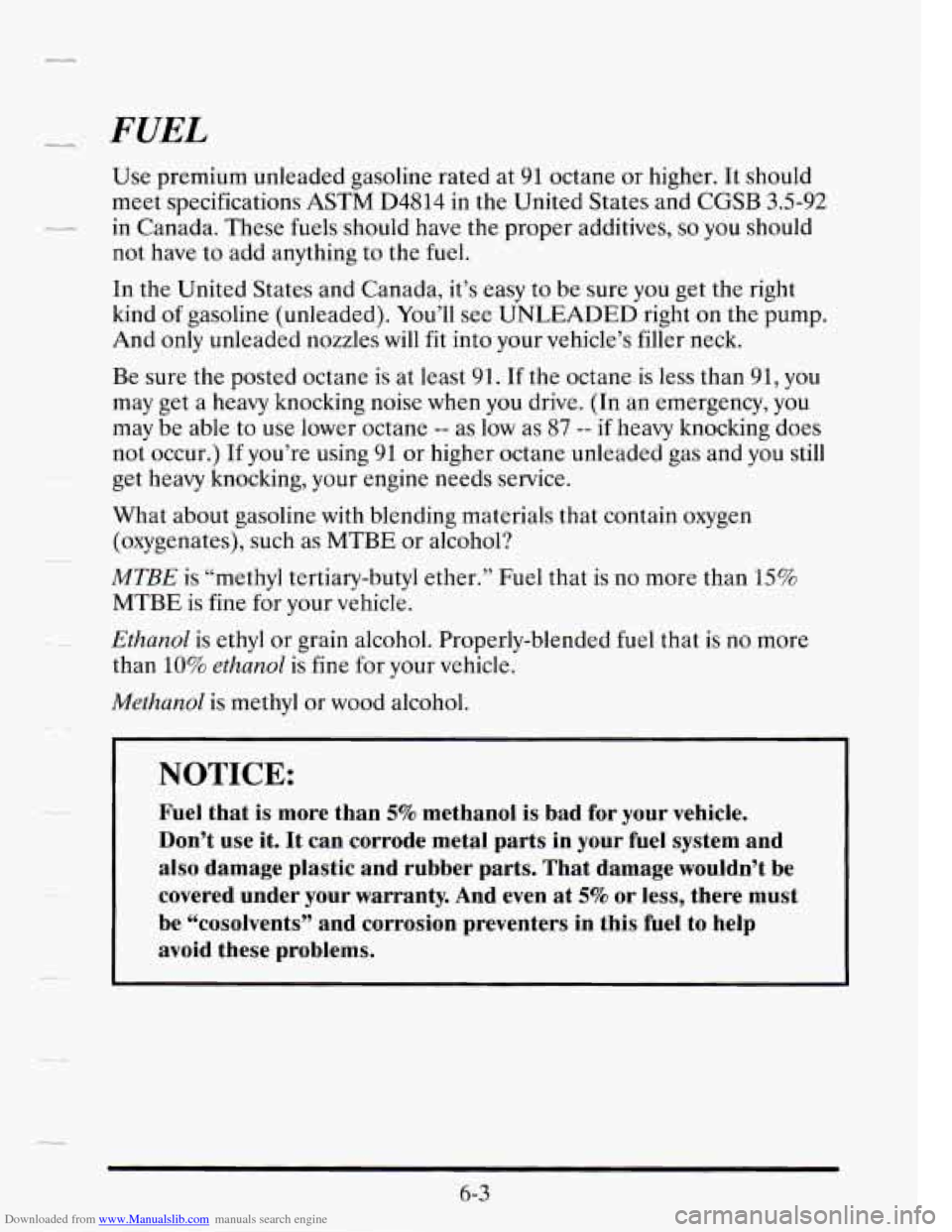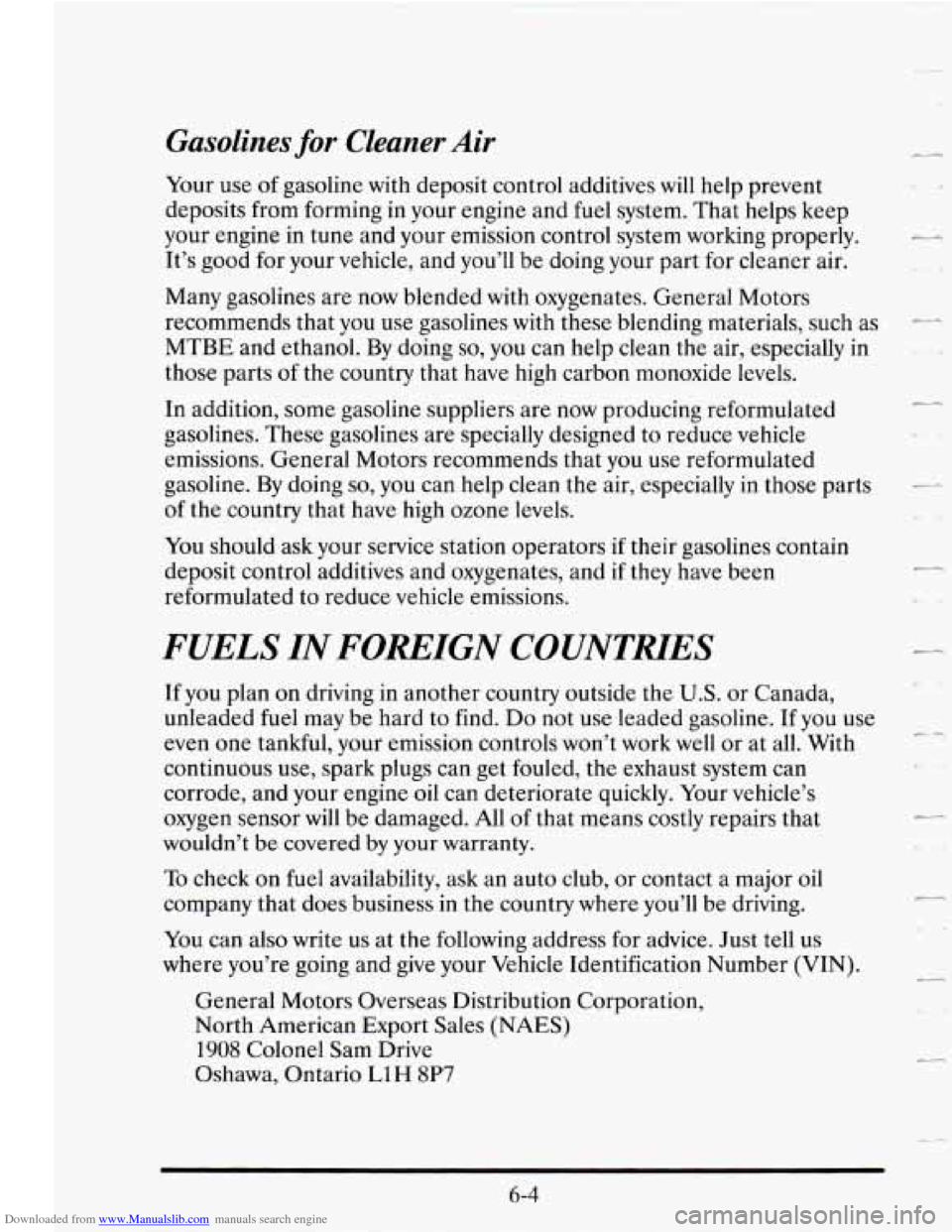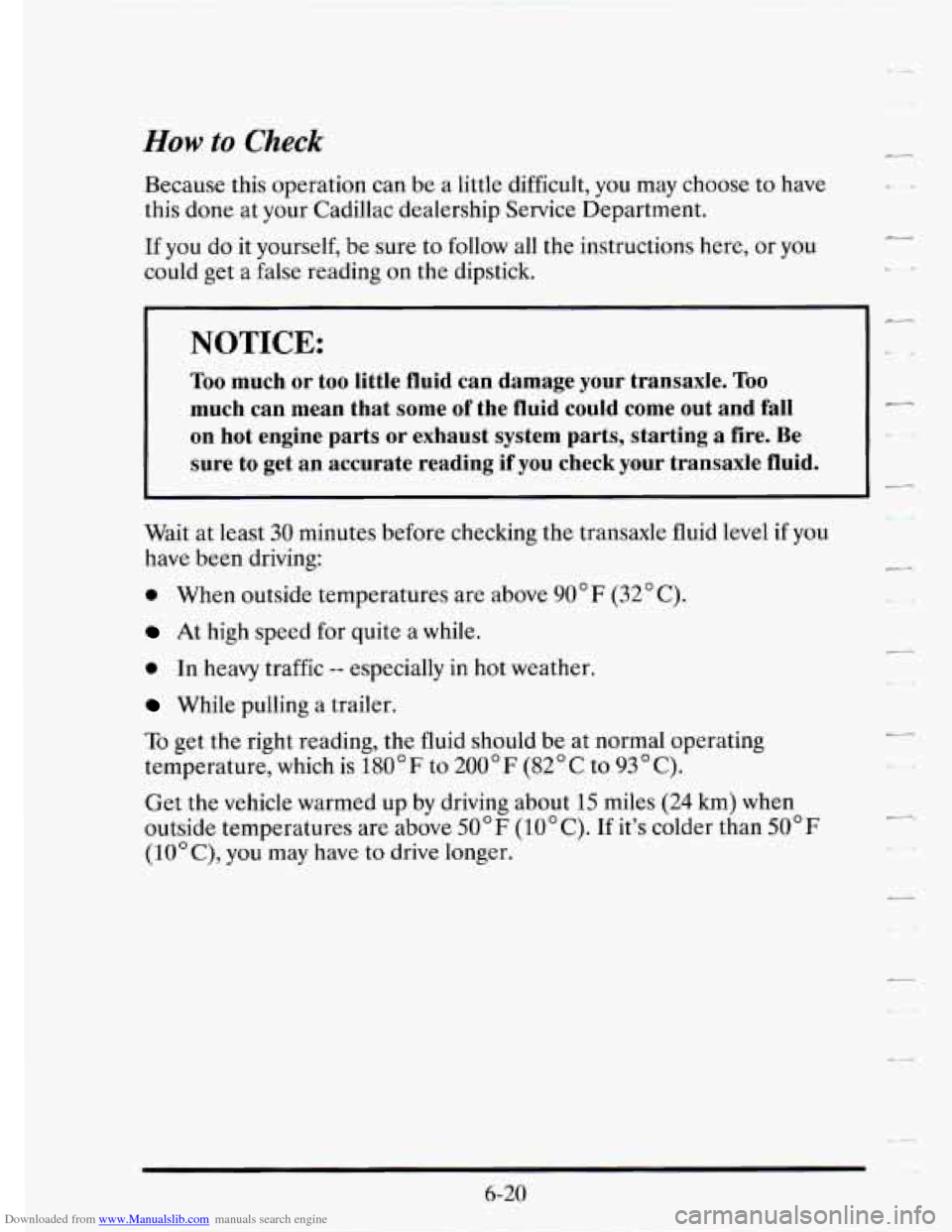Page 272 of 410
Downloaded from www.Manualslib.com manuals search engine Lu
SERVICE AND APPEARANCE CARE
Here you will find information about the care of your Cadillac. This
section begins
with service and fuel information, and then it shows how to
check important fluid and lubricant levels. There is also technical
information about your vehicle, and
a part devoted to its appearance care.
SERWCE
Your Cadillac dealer knows your vehicle best and wants you to be happy
with it. We hope you’ll go to your dealer for all your service needs. You’ll
get genuine GM parts and GM-trained and supported service people.
We hope you’ll want
to keep your GM vehicle all GM. Genuine GM parts
have one
of these marks:
Delco
6-1
Page 273 of 410
Downloaded from www.Manualslib.com manuals search engine Doing Your Own Service Work
If you want to do some of your own service work, you’ll want to get the
proper Cadillac Service Manual. It tells you much more about how to
service your Cadillac than this manual can.
To order the proper service
manual, see “Service Publications”
in the Index.
Your vehicle has an air bag system. Before attempting to do your
own
service work, see “Servicing Your Air Bag-Equipped Cadillac” in the
Index.
You should keep a record with all parts receipts and list the mileage and
the date of any service work you perform. See “Maintenance Record”
in
the Index.
NOTICE: I
If you try to do your own service work without knowing enough
about it, your vehicle could be damaged.
c-
6-2
Page 274 of 410

Downloaded from www.Manualslib.com manuals search engine -_ -
FUEL
Use premium unleaded gasoline rated at 91 octane or higher. It should
meet specifications
ASTM D4814 in the United States and CGSB 3.5-92
in Canada. These fuels should have the proper additives, so you should
not have to add anything to the fuel.
In the United States and Canada, it’s easy to be sure you get the right
kind
of gasoline (unleaded). You’ll see UNLEADED right on the pump.
And only unleaded nozzles will fit into your vehicle’s filler neck.
Be sure the posted octane
is at least 91. If the octane is less than 91, you
may get a heavy knocking noise when you drive. (In an emergency, you
may be able to use lower octane
-- as low as 87 -- if heavy knocking does
not occur.) If you’re using 91 or higher octane unleaded gas and you still
get heavy knocking, your engine needs service.
What about gasoline with blending materials that contain oxygen
(oxygenates), such as
MTBE or alcohol?
MTBE is “methyl tertiary-butyl ether.” Fuel that is no more than 15%
MTBE is fine for your vehicle.
Ethanol is ethyl or grain alcohol. Properly-blended fuel that is no more
than
10% ethanol is fine for your vehicle.
Methanol is methyl or wood alcohol.
I NOTICE:
Fuel that is more than 5% methanol is bad for your vehicle.
Don’t use it.
It can corrode metal parts in your fuel system and
also damage plastic and rubber parts. That damage wouldn’t be
covered under your warranty. And even at
5% or less, there must
be “cosolvents” and corrosion preventers in this fuel to help
avoid these problems.
6-3
Page 275 of 410

Downloaded from www.Manualslib.com manuals search engine Gasolines for Cleaner Air
Your use of gasoline with deposit control additives will help prevent
deposits from forming in your engine and
fuel system. That helps keep
your engine in tune and your emission control system working properly.
It’s good for your vehicle, and you’ll be doing your part for cleaner air.
Many gasolines are now blended with oxygenates. General Motors
recommends that you use gasolines with these blending materials, such as
MTBE and ethanol. By doing
so, you can help clean the air, especially in
those parts
of the country that have high carbon monoxide levels.
In addition, some gasoline suppliers are now producing reformulated
gasolines. These gasolines are specially designed to reduce vehicle
emissions. General Motors recommends that you use reformulated
gasoline.
By doing so, you can help clean the air, especially in those parts
of the country that have high ozone levels.
You should ask your service station operators if their gasolines contain
deposit control additives and oxygenates, and
if they have been
reformulated to reduce vehicle emissions.
FUELS IN FOREIGN COUNTMES
If you plan on driving in another country outside the U.S. or Canada,
unleaded fuel may be hard to find.
Do not use leaded gasoline. If you use
even one tankful, your emission controls won’t work well or at
all. With
continuous use, spark plugs can get fouled, the exhaust system can
corrode, and your engine
oil can deteriorate quickly. Your vehicle’s
oxygen sensor
will be damaged. All of that means costly repairs that
wouldn’t be covered by your warranty.
To check on fuel availability, ask an auto club, or contact a major oil
company that does business in the country where you’ll be driving.
You can also write us at the following address for advice. Just tell us
where you’re going and give your Vehicle Identification Number (VIN).
General Motors Overseas Distribution Corporation,
North American Export Sales
(NAES)
1908 Colonel Sam Drive
Oshawa, Ontario
L1H 8P7
6-4
Page 286 of 410

Downloaded from www.Manualslib.com manuals search engine - Engine Coolant Heater
An engine coolant heater can be a big help if you have to park outside in
very cold weather,
O°F (-HOC) or colder. If your vehicle has this option,
c- see “Engine Coolant Heater” in the Index.
What to Do with Used Oil
Did you know that used engine oil contains certain elements that may be
unhealthy for your skin and could even cause cancer? Don’t let used oil
stay on your skin
for very long. Clean your skin and nails with soap and
:water, or a good hand cleaner. Wash or properly throw away clothing or
rags containing used engine oil. (See the manufacturer’s warnings about
the use and disposal
of oil products.)
-
-__+
Used oil can be a real threat to the environment. If you change your own
oil, be sure
to drain all free-flowing oil from the filter before disposal.
Don’t ever dispose of oil by putting it in the trash, pouring it on the
ground, into sewers, or
into streams or bodies of water. Instead, recycle it
by taking it to a place that collects used oil. If you have a problem
properly disposing
of your used oil, ask your dealer, a service station or a
local recycling center for help.
6-15
Page 291 of 410

Downloaded from www.Manualslib.com manuals search engine How to Check
Because this operation can be a little difficult, you may choose to have
this done at your Cadillac dealership Service Department.
If
you do it yourself, be sure to follow all the instructions here, or you
could get a false reading on the dipstick.
NOTICE:
LI
Too much or too little fluid can damage your transaxle. Too
much can mean that some of the fluid could come out and fall l-
on hot engine parts or exhaust system parts, starting a fire. Be
sure to get an accurate reading
if you check your transaxle fluid.
Wait at least 30 minutes before checking the transaxle fluid level if you
have been driving:
0 When outside temperatures are above 90 " F (32 C).
At high speed for quite a while.
0 In heavy traffic -- especially in hot weather.
While pulling a trailer.
To get the right reading, the fluid should be at normal operating
temperature, which is
180 " F to 200 F (82 C to 93 " C).
Get the vehicle warmed up by driving about 15 miles (24 km) when
outside temperatures are above
50°F (10°C). If it's colder than 50°F
(lO°C), you may have to drive longer.
6-20
Page 305 of 410
Downloaded from www.Manualslib.com manuals search engine EXTElUOR LA2MP HOUSINGS
Your Cadillac’s lamp housings are designed with small vents so moisture *- 1
will be removed when the lights are on, or after driving for a short time. If
an excessive amount of moisture is present which does not clear, see your -
Cadillac dealer for service.
HEmMP BULB REMOVL
The following procedure tells you how to remove the halogen headlamp
bulb. Follow either the
EXPORT or DOMESTIC illustration that best
describes your vehicle.
1
bJ
6-34
Page 314 of 410
Downloaded from www.Manualslib.com manuals search engine TIRES
We don’t make tires. Your new vehicle comes with high-quality tires made
by a leading tire manufacturer.
If you ever have questions about your tire
warranty and where to obtain service, see
your Cadillac Warranty booklet
for details.